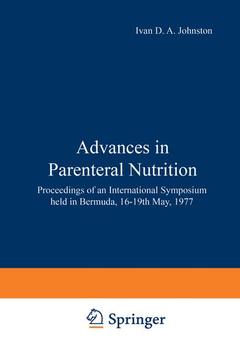Advances in Parenteral Nutrition, Softcover reprint of the original 1st ed. 1978 Proceedings of an International Symposium held in Bermuda, 16–19th May, 1977
Langue : Anglais
Coordonnateur : Johnston I.D.A.

Parenteral nutrition has been one of the most significant therapeutic advances of the past twenty years. Many patients have survived very serious illness only because of intravenous nutrition for either short or very long periods of time. The indications for parenteral nutrition are simple and can be summarised as the inability to ingest necessary nutrients for a significant time during increased metabolic demands. Many problems in the preparation of energy sources and amino acid solutions have been solved so that the time is opportune to review what has been achieved and discuss recent advances and current thinking in the light of future requirements. The next phase in parenteral nutrition will undoubtedly be the provision of regimens designed for specific situations. The needs of the neonate for example are known to differ from adult requirements. The choice of carbohydrate for intravenous use has been a matter of much of glucose both in biochemical and clinical terms discussion. The supremacy now seems well established. The value of intravenous fat is well documented, but the interchange of fat and carbohydrate as calorie sources and the effects of prolonged infusions of fat merit further investigation. The evidence that isotonic amino acids are utilized effectively when given alone due to the availability of endogenous energy sources has led to a greater understanding of the metabolic changes and demands associated with injury and sepsis.
Section I Foundations of Parenteral Nutrition.- 1. Metabolic foundations of intravenous nutrition.- Section II Carbohydrates in Parenteral Nutrition.- 2. Some general considerations concerning the use of carbohydrates in parenteral nutrition.- 3. Metabolic pathways for carbohydrates in parenteral nutrition.- 4. Short-term parenteral nutrition with and without fructose.- 5. Evaluation of non-glucose carbohydrates in parenteral nutrition.- Panel Discussion.- Section III Amino Acids in Parenteral Nutrition.- 6. Intracellular amino acids and energy metabolism in catabolic patients with regard to muscle tissue.- 7. Biological limiting factors to parenteral amino acid feeding in man.- 8. Isotonic crystalline amino acids for protein sparing.- 9. The protein-sparing effect of isotonic amino acids: metabolic considerations.- Section IV Fat Emulsions in Parenteral Nutrition.- 10. Use of fat emulsions in parenteral nutrition.- 11. Lipid metabolism in stress.- 12. Role of lipid as a source of nonprotein calories.- 13. Effect of long-term administration of fat emulsion on lipid deposition in the reticuloendothelial system in man.- 14. Toxicity of lipids.- Section V Trace Elements in Parenteral Nutrition.- 15. Trace element formulations in intravenous feeding.- 16. Zinc and other trace elements.- Panel Discussion.- Section VI Parenteral Nutrition in Paediatrics.- 17. Aspects of intravenous feeding in childhood.- 18. Study of the use of total parenteral nutrition in neonates suffering from necrotizing enterocolitis.- 19. Use of Travasol in paediatric patients.- 20. Abnormalities of amino acid metabolism in the newborn.- Section VII Control of Infection in Parenteral Nutrition.- 21. Microbial hazards in the assembly of intravenous infusions.- 22. Bacterial contamination of intravenousinfusions due to faulty technique.- 23. The incidence of nosocomial infection in patients receiving total parenteral nutrition.- 24. Tracing sources of infection associated with parenteral infusions.- Section VIII Biochemical Aspects of Parenteral Nutrition.- 25. Acid-base balance during parenteral nutrition with Travasol.- 26. Metabolic complications of parenteral nutrition.- 27. The compatibility of extemporaneously added drug additives with Travasol (amino acid) injection.- Section IX Clinical Aspects of Parenteral Nutrition.- 28. Clinical experience of total parenteral nutrition.- 29. Protein sparing therapy during prolonged ileus.- 30. Cholestatic jaundice during parenteral alimentation in adults.- 31. The importance of parenteral nutrition as an adjunct to cancer treatment.- 32. Artificial nutrition and the gastrointestinal tract: some clinical and experimental data.- Section X Parenteral Nutrition and Body Composition: Assessment of Therapy.- 33. The tissue composition of surgical weight loss.- 34. Research in malnutrition and its application to parenteral feeding.- 35. The use of body composition measurements to assess the efficacy of parenteral nutrition.- 36. Use of 40K counting and its relationship to other estimates of lean body mass.- Appendix — SI units.
Date de parution : 08-2014
Ouvrage de 581 p.
15.5x23.5 cm
Thème d’Advances in Parenteral Nutrition :
Mots-clés :
© 2024 LAVOISIER S.A.S.



